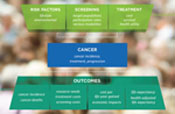Maximizing the impact of cancer care by supporting informed decisions on cancer interventions
New Cancer Risk Management Model uses web-based technology to project results
February 8, 2012
 If each Canadian province and territory could lower its population’s smoking rate to below 20%, what might be the impact on the incidence of lung cancer across the country? How much might potential treatment and associated economic costs of lung cancer go down? How do we compare the projected results of a dollar invested in smoking cessation with the results of a dollar invested in a new cancer therapy?
If each Canadian province and territory could lower its population’s smoking rate to below 20%, what might be the impact on the incidence of lung cancer across the country? How much might potential treatment and associated economic costs of lung cancer go down? How do we compare the projected results of a dollar invested in smoking cessation with the results of a dollar invested in a new cancer therapy?
These are the kinds of questions that Canada’s health planners, policy analysts, health economists, biostatisticians, epidemiologists and cancer researchers grapple with daily. The Partnership’s newly developed Cancer Risk Management Model, a comprehensive web-based decision support tool, is now available to help calculate the answers to these and many other questions.
Developed collaboratively by a team of Statistics Canada specialists, Canadian cancer leaders and software experts, the Cancer Risk Management Model uses computer simulations to project how key cancer control initiatives might play out in practice. Projections could include the impact on the number of cancers, mortality rates by cancer site, life expectancy, deaths averted and health-adjusted life expectancy. The model draws on a broad range of the latest evidence related to the incidence and progression of, and deaths from, cancers in Canada. The Cancer Risk Management Model can also provide projections of the economic effects of cancer control on patients’ lives, the health-care system and government finances.
“This tool provides health planners from across the country with a single framework for testing a variety of cancer control scenarios to quickly generate the type of information they need to make policy decisions,” says Andy Coldman, Vice-President of Population Oncology at the BC Cancer Agency. “These decisions have the potential to improve population health and reduce the economic costs of cancer.”
Although designed for direct and easy use by cancer control and other health-related decision-makers, the Cancer Risk Management Model can be a useful tool to help researchers to examine complex research questions.
The platform initially focused on lung and colorectal cancer, which are the leading cause of cancer deaths for Canadian men and women. The model was later expanded to include lung cancer screening using low-dose computer tomography and cervical cancer control with HPV vaccination and screening. Plans are underway to add breast cancer in late 2012 and will continually be expanded to conduct comprehensive analysis of the impacts on all cancers.
“The Partnership is leading development of the Cancer Risk Management Model platform as part of its mandate to drive system-wide improvements through the synthesis and dissemination of best-available information,” says Janey Shin, a member of the development team and the Partnership’s Director of Analytics and Surveillance. “The tool aims to measure the long-term impacts of the coordinated efforts of Canada’s cancer control strategy and to establish a sound basis for ongoing system-wide improvements in this area.”
For more information, please visit www.cancerview.ca/cancerriskmanagement.
